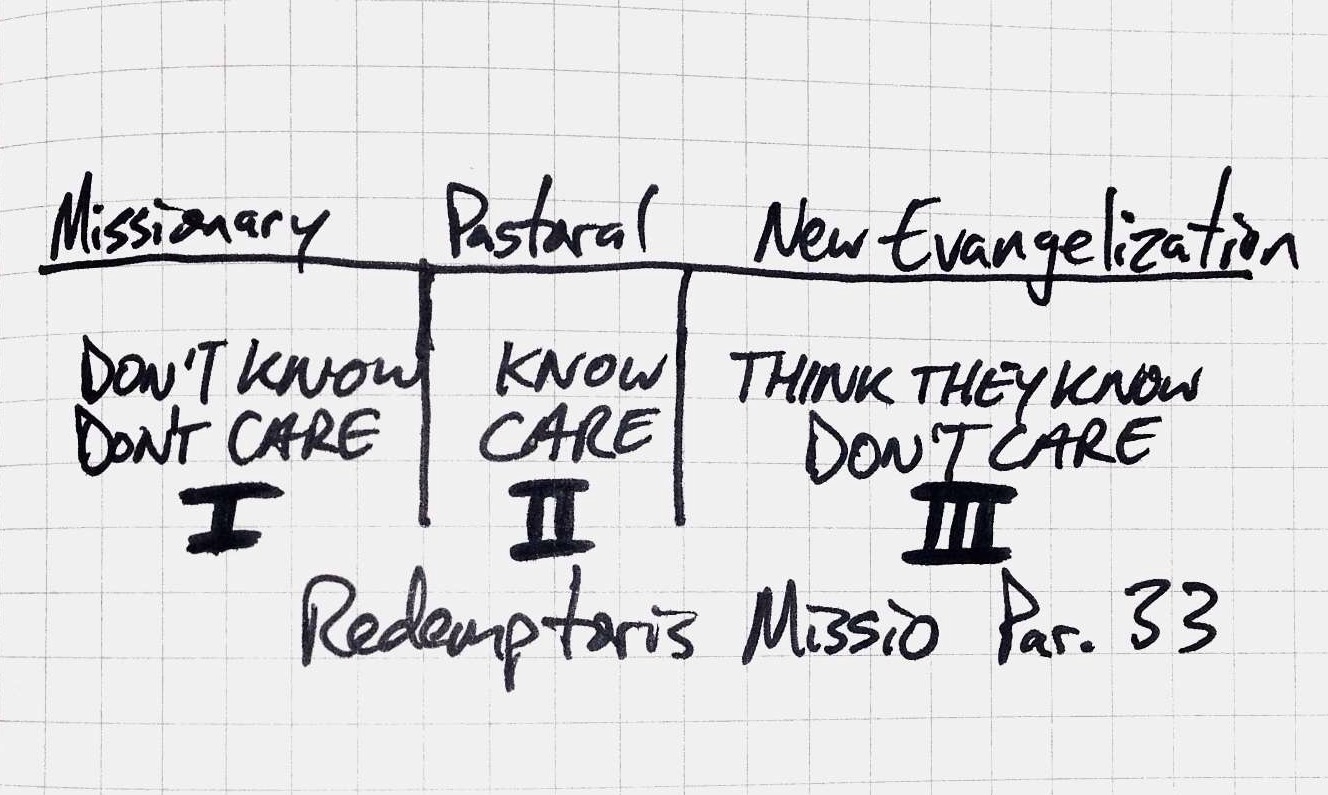An Evangelistic Model for Youth Ministry
There are a few problems I’ve come across frequently in conversations about youth ministry. The first is sweeping generalizations. “Large group models suck.” Or “Life Teen is inadequate.” Or “We need more cowbell.” Most critiques of any type of youth ministry model I’ve read create a straw man based on personal experiences of deficient youth ministry. A good model or strategy can always be poorly executed. Another problem is a misunderstanding of the purpose of different types of events or programs a youth ministry may do. To me, looking at the large group event and crying “This doesn’t go deep enough or make disciples!” is like expecting an Alpha course to prepare people for Baptism. That's not the purpose of Alpha. There are multiple contact points with youth that should constantly be pointing to a next step in the Christian life.
What I don't see much of is anyone formally proposing a model of youth ministry that extends beyond a specific weekly event. I wanted to propose a paradigm loosely based on the Catechumenate that I currently believe is the best way to approach youth ministry.
The Mission Territory
Youth ministry reaches out to a specific mission territory in a specific time and place and culture. Pope St. John Paul II in Redemptoris Missio defined three mission situations of evangelization that exist today.
First is the situation in which people haven’t heard and therefore don’t care about Jesus Christ and the Gospel. This is the area of ad gentes missionary activity.
The second is the situation in which people have heard and do care about Jesus and his Gospel. This is the area of pastoral activity.
The third, and most culturally common, is the situation in which people have heard or think they’ve heard about Jesus and everything He has to offer, and have decided to reject it. This is apparent in America even on the scale of whole families, generations, or communities. They’ve been exposed to the Church in some degree, and have rejected it. This is where the need for the “new” evangelization comes from. It is a new territory to be evangelizing people who have already been exposed to the Gospel message and are not hearing it for the first time.
I think this third situation is the most commonly experienced in youth ministries around the country. But to some degree all three situations are present and should be dealt with if youth ministry is going to make disciples.
Acts 2
The Catechumenate is an ancient model of Christian Initiation that has been used in some form since the Early Church. It is a process that leads a person on the fringes of the Church into full sacramental communion with Jesus Christ within the Church. In our post-Christian cultural context of Catholics who are sacramentalized but not evangelized, I think the Catechumenate is still a powerful organizing model for evangelization, because of its focus on conversion and movement.
The Catechumenate exists in a seminal form as early as Acts 2. Go read Acts 2. Do it.
The Apostles "going out" into Jerusalem after Pentecost caused non-Christians to take notice. They were amazed and perplexed and asked "What does this mean?" St. Peter stands up and gives the first sermon of the post-Pentecost Catholic Church and proclaims the kerygma, or the proclamation of Jesus Christ and the Gospel. The crowd is "cut to the heart" and asks "What shall we do?" This is a moment of conversion and they crave to respond to what they've heard. "Repent, and be baptized every one of you in the name of Jesus Christ for the forgiveness of your sins and you will receive the gift of the Holy Spirit."
So the three thousand in the crowd do as Peter recommends and they enter the Church, the first RCIA class of 33 A.D. But what do you do with three thousand newly baptized Christians? Form Church communities where the Christians can live out discipleship! What does that look like?
"And they devoted themselves to the apostle's teaching and the communal like, to the breaking of bread and to prayer." Acts 2:42
I'll save my rant about the Catechism (creed, sacraments, morality, and prayer) and its importance in the whole discipleship conversation for later.
A Process of Evangelization
The early Church's evangelization efforts, and the Catechumenate, take on this loose rhythm:
I think this is the best way to organize a youth ministry because it focuses on outreach, conversion, movement, and discipleship. Its christocentric. It is balanced. Focus too much on one area and you'll have unhealthy results. If we aren't focused on conversion, then we are just running a club. If we aren't intentionally focused on moving teens from where they towards a deeper relationship with Christ, then they are moving backwards. If we aren't focused on discipleship and only focused on initial proclamation, then we are providing a superficial spiritual high.
It also takes into consideration and addresses the various levels of commitment to Christ a large group of teens will have.
Fringe
"They were perplexed and amazed and asked "What does this mean?" but others mocking said "They are filled with new wine." Acts 2:12
You'll notice that there were two reactions to the Apostles. One was open and curious and one was hostile. Just like JPII's three situations of evangelization, there are two forms of fringe youth: those who have never really heard the Gospel, and those who are openly rejecting it. The first step in youth ministry is engaging and building trust with youth on the fringes of the Church.
Examples: meeting teens at school, going to sports games, fun social activities, outreach outside the parish, softball tournaments
Proclamation (kerygma)
"Men of Israel, hear these words: Jesus of Nazareth..." Acts 2:14-36 "Now when they heard this they were cut to the heart...'What shall we do?'"Acts 2:37
St. Peter proclaimed, in a powerful and definitive way, the Person of Jesus Christ and the Gospel message. He appealed to the life, death, and resurrection of Jesus, the prophecies that foretold his coming, and the witness of the Apostles. It was intentional and direct and it cut them to the heart. It demanded a response. Youth ministry needs to create moments where the basic Gospel message can be proclaimed to youth in a way that demands a response from them.
Examples: large group model, Lifeteen model, Steubenville Conferences, Covecrest, Summer camps, Confirmation retreats
Conversion (metanoia)
"Repent and be baptized every one of you in the name of Jesus Christ for the forgiveness of your sins; and you shall receive the same Holy Spirit." Acts 2:38-40
The climactic transitional moment for the hearers marks a turning point where they no longer are passive or on the outside. They make a public and definite decision to repent of sin and "turn" their lives fully over to Jesus, beginning discipleship. They encounter the Person of Jesus Christ in the sacraments and become initiated into the Church
Examples: Connecting youth to the sacraments, Mass, encouraging repentance of sin, renewal of baptismal promises, adoration, Confession
Discipleship (didache)
"And they devoted themselves to the Apostles' teaching and the communal life, to the breaking of bread and to the prayers." Acts 2:42
Only AFTER conversion can the newly initiated begin diving deep into the demands of discipleship. This is the place for proper catechesis and for a challenging of youth to dive deep into the life of a disciple. This stage requires more individual attention and accountability, and small groups seem best suited for this period of growth.
Examples: small group model, yDisciple, Bible study, discipleship, Forming Intentional Disciples, deeper formation and catechesis
Mission (apostolos)
"Go therefore and make disciples of all nations..." Matthew 28:19
The final stage of discipleship is being sent by Christ with the mission of the Church to go make disciples. You'll know your ministry is thriving and youth are maturing when they begin using their charisms and gifts to go out and make disciples of others.
Examples: youth taking on ministry, youth helping lead small groups, giving their witness, putting on retreats, giving talks, leading others in discipleship
So...
This is just a quick glance at the way I've grown to think about youth ministry. None of this is mine, its all stolen from a hundred different places. There is so much more that I could have said and have left out, but I think this gives a good starting point. The big takeaway is that there are so many ways this can be accomplished. But I do stand by the argument that this is one of the most effective ways to approach and think about structuring a youth ministry at a parish.
What do you think?



